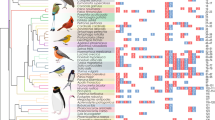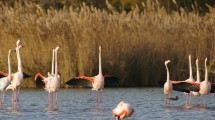Summary
Males of many animals have more than a single exaggerated secondary sexual character, but inter-specific variability in the number of ornaments has never been explained. We examine three hypotheses that may account for the presence of multiple ornaments. First, the multiple message hypothesis proposes that each display reflects a single property of the overall quality of an animal. This is likely to be the case for ornaments that respond to condition on different time scales. Second, the redundant signal hypothesis suggests that each ornament gives a partial indication of condition. Females pay attention to several sex traits because in combination they provide a better estimate of general condition than does any single ornament. The redundant signal hypothesis predicts that (i) multiple ornaments should be particularly common among taxa with relatively uncostly and fine-tuned female choice, and (ii) females pay equal attention to the expression of all the secondary sex traits in order to obtain an estimate of overall male condition. Finally, the unreliable signal hypothesis argues that some ornaments are unreliable indicators of overall condition and are only maintained because they are relatively uncostly to produce and there is a weak female preference for them. This predicts that (i) multiple sexual ornaments should be particularly common in taxa with the most intense sexual selection (i.e. lekking and other polygynous taxa), and (ii) there should be more evidence for condition dependence in ornaments of species with single as opposed to multiple ornaments. Both the latter predictions are supported by data on feather ornaments in birds.
Similar content being viewed by others
References
Andersson M (1980) Why are there so many threat displays? J Theor Biol 86:773–781
Andersson M (1986) Evolution of condition-dependent sex ornaments and mating preferences: sexual selection based on viability differences. Evolution 40:804–820
Clarke JM, McKenzie JA (1987) Developmental stability of insecticide resistant phenotypes in blowfly; a result of canalizing natural selection. Nature 325:345–346
Darwin C (1871) The descent of man, and selection in relation to sex. John Murray, London
Evans MR, Hatchwell BJ (1992) An experimental study of male adornment in the scarlet-tufted malachite sunbird. I. The role of pectoral tufts in territorial. Behav Ecol Sociobiol 29:413–419
Evans MR, Thomas ALR (1992) The aerodynamic and mechanical consequences of elongated tails in the scarlet tufted malachite sunbird: Measuring the cost of a handicap. Anim Behav 43:337–347
Fisher RA (1930) The genetical theory of natural selection. Clarendon Press, Oxford
Grafen A (1990) Sexual selection unhandicapped by the Fisher process. J Theor Biol 44:475–516
Hamilton WD (1986) Instability and cycling of two competing hosts with two parasites. In: Karlin S, Nevo A (eds) Evolutionary processes and theory. Academic Press, New York, pp 645–668
Harvey P, Pagel M (1991) The comparative method in evolutionary biology. Oxford University Press, Oxford
Hedrick AV (1988) Female choice and the heritability of attractive male traits: an empirical study. Am Nat 132:267–276
Höglund J (1989) Size and plumage dimorphism in lek-breeding birds: a comparative analysis. Am Nat 134:72–87
Iwasa Y, Pomiankowski A, Nee S (1991) The evolution of costly mate preferences. II. The “handicap” principle. Evolution 45:1431–1442
Kirkpatrick M (1982) Sexual selection and the evolution of female choice. Evolution 36:1–12
Kirkpatrick M (1987) The evolutionary forces acting on female mating preferences in polygynous animals. In: Bradbury J, Andersson MB (eds) Sexual selection: testing the alterantives. Wiley, Chichester, pp 67–82
Kodric-Brown A (1989) Dietary carotenoids and male mating success in the guppy: an environmental component to female choice. Behav Ecol Sociobiol 25:393–401
Kodric-Brown A, Brown JH (1984) Truth in advertising: the kinds of traits favored by sexual selection. Am Nat 124:303–323
Lande R (1981) Models of speciation by sexual selection on polygenic traits. Proc Natl Acad Sci USA 78:3721–3725
Leamy L, Atchley W (1985) Directional selection and developmental stability: Evidence from fluctuating asymmetry of morphometric characters in rats. Growth 49:8–18
Ludwig W (1932) Das Rechts-Links-Problem im Tierreich und beim Menschen. Springer, Berlin
Milinski M, Bakker TCM (1990) Female sticklebacks use male coloration in mate choice and hence avoid parasitized males. Nature 344:330–332
Møller AP (1990) Fluctuating asymmetry in male sexual ornaments may reliably reveal male quality. Anim Behav 40:1185–1187
Møller AP (1991) Sexual ornaments size and the cost of fluctuating asymmetry. Proc Roy Soc London B 243:59–62
Møller AP (1992a) Frequency of female copulations with multiple males and sexual selection. Am Nat 139:1089–1101
Møller AP (1992b) Female swallow preference for symmetric male sexual ornaments. Nature 357:238–240
Møller AP (1993) Patterns of fluctuating asymmetry in sexual ornaments predict female choice. J Evol Biol (in press)
Moller AP, Höglund J (1991) Patterns of fluctuating asymmetry in avian feather ornaments: implications for models of sexual selection. Proc R Soc London B 245:1–5
Møller AP, Pomiankowski A (1993a) Punctuated equilibria or gradual evolution: Fluctuating asymmetry and variation in the rate of evolution. J Theor Biol (in press)
Møller AP, Pomiankowski A (1993b) Fluctuating asymmetry and sexual selection. Genetica (in press)
Palmer AR, Strobeck C (1986) Fluctuating asymmetry: measurement, analysis, pattern. Annu Rev Ecol Syst 17:391–421
Parsons PA (1990) Fluctuating asymmetry: an epigenetic measure of stress. Biol Rev 65:131–145
Pomiankowski A (1987) The costs of choice in sexual selection. J Theor Biol 128, 195–218
Pomiankowski A, Iwasa Y, Nee S (1991) The evolution of costly mate preferences. I. Fisher and biased mutation. Evolution 45:1422–1430
Sebeok TA (1977) How animals communicate. Indiana University Press, Bloomington
Silbley CG, Ahlquist JE (1990) Phylogeny and classification of birds. Yale University Press, New Haven London
Soulé ME (1982) Allometric variation. 1. The theory and some consequences. Am Nat 120:751–764
Taylor PD, Williams GC (1982) The lek paradox is not resolved. Theor Popul Biol 22:392–409
Thoday JM (1958) Homeostasis in a selection experiment. Heredity 12:401–415
Thomas ALR (1992) On the aerodynamics of bird tails. Phil Trans R Soc B (in press)
Tinbergen N (1959) Comparative studies of the behaviour of gulls (Laridae): a progress report. Behavior 15:1–70
Trivers RL (1972) Parental investment and sexual selection. In: Campbell B (ed) Sexual selection and the descent of man, 1871–1971. Aldine, Chicago, pp 136–179
Van Valen L (1962) A study of fluctuating asymmetry. Evolution 16:125–142
Zahavi A (1975) Mate selection — a selection for a handicap. J Theor Biol 53:205–214
Zuk M, Thornhill R, Ligon JD (1990) Parasites and mate choice in red jungle fowl. Am Zool 30:235–244
Author information
Authors and Affiliations
Additional information
Correspondence to: A. Pomiankowski
Rights and permissions
About this article
Cite this article
Moller, A., Pomiankowski, A. Why have birds got multiple sexual ornaments?. Behav Ecol Sociobiol 32, 167–176 (1993). https://doi.org/10.1007/BF00173774
Received:
Accepted:
Issue Date:
DOI: https://doi.org/10.1007/BF00173774




